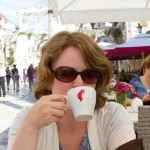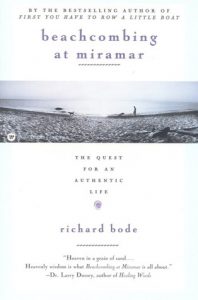 I read Beachcombing at Miramar: The Quest for an Authentic Life by Richard Bode just as I was changing jobs earlier this summer and somewhat terrified that I’d never write again. Things are better now, as of this weekend I have two books started and a jumble of poetry I vow to someday edit, so I feel like I can finally talk about this book and what it means to me.
I read Beachcombing at Miramar: The Quest for an Authentic Life by Richard Bode just as I was changing jobs earlier this summer and somewhat terrified that I’d never write again. Things are better now, as of this weekend I have two books started and a jumble of poetry I vow to someday edit, so I feel like I can finally talk about this book and what it means to me.Isolation
Bode retreated to his house on the beach after a divorce from a marriage it sounds like he was never that into. And this book is a collection of essays about the year he spent beachcombing. Like many memoirs (most particularly Walden), it feels carefully trimmed to highlight the experiences that string together into the best narrative. I guess fiction does that too, but in this instance, especially as he talks about his isolation, I wondered if he was anywhere near as removed from society as I dreamed he was.
“Since they have never learned how to be by themselves, they have never learned how to be together.” – Richard Bode
My relationship with isolation is cloudy. A first born, there was a time in my life where I was very happy with only my own company, but I feel like my parents resisted this impulse in me. Perhaps because of the adorable baby brother who soon followed or just to fit into society in general. But somewhere very early I got the impression (in a way that was difficult to argue with) that I was supposed to be social. I started flitting from group to group engaging just enough to feel like I’d satisfied the requirements and then I’d go on to the next. But I never again settled into my own company.
Even in grad school for writing, a time when I should have been most deeply immersed in my thoughts, I was experiencing an immense push-pull between the isolation I craved and the importance of sociability that I’d internalized.
But there are times when a writer cannot be social. It’s perhaps the lonesomest of careers (and maybe that’s why it calls to me). Because I work with words, the slightest verbal interruption can throw me off completely—sometimes for the whole day (especially when I’m in that nuance of language place). I cannot even listen to music with lyrics.
And yet, I’m still pushing and pulling myself about whether that isolation is okay. Often all it takes is a declaration of intent that “I will be writing today and cannot be interrupted” for me to then turn around and follow my husband around the house all day (unlike Bode, I’m very lucky in my choice of spouse).
The best times—the most productive times— are when I find balance, as I believe Bode did, between the alone time required to think and create and the social time that almost everyone wants some degree of. To do that, I have to give myself permission to be alone sometimes and to be honest with myself about the times when I don’t.
Inspiration
“Where does your inspiration come from?” has to be the most frequently asked question of writers. With this book, Bode allowed himself time to think and to observe the world. Although his book is self-referential (inspiration comes from the very time and space that he’s writing about), I believe the magic of inspiration actually comes from an artist’s brain.
I’m not saying that artists have different ways of thinking than others—that would imply some sort of biological predisposition toward art I’m not prepared to champion—but I do believe the openness, fluidity, and tangential nature of thought are necessary to the creation of art. Because the magic of inspiration is actually the magic of connections that we make, of looking at the same thing as everyone else from a fresh angle. Some of that is allowing ourselves the time to think, and some of it is allowing ourselves the space to see whatever it is we are looking at in the light of our unique experiences (and then honing the skills to express that viewpoint).
“I have a task that is greater than all the labors assigned to Hercules. It demands that I live in the richness of this moment because that is all I have or will ever know.” – Richard Bode
Bode is just walking up and down the beach. But by being on that beach through the seasons, he sees the experience of being there in a different way. The thoughts in his mind are shaped by that presence and evolve into something a day visitor might not understand. It’s pretty wonderful.
And inspiration, as long as you are open to it, really is inexhaustible (I’m sure I’ll kick myself for writing that someday, but I do believe it). At work this week, I was treated to this presentation:
That was at a marketing conference. But because I didn’t have my head stuck in the “this is the place I work” vs. “this is the place I write” rut, this fabulous presentation inspired me professionally and personally. Not every part of this presentation will be tailor made for you. That’s the point. Pluck the parts that resonate and marry them with something else and go make work.
There is a line from Gattaca that is with me always. Vincent (Ethan Hawke) is explaining to his much more athletic brother how he beat him at swimming this vast distance when they were kids. He says, “You want to know how I did it? This is how I did it, Anton: I never saved anything for the swim back.” If you are saving back ideas for the next project or for the right moment, you are holding back a part of yourself. Go back to that presentation above. Check out slide 7. Then slide 8. 20. 21.
The time to make your best work about that burning issue is right now. Because tomorrow something else might be burning and you will have lost that moment forever.
Coping with Fear
“The individual who fears the criticism of others is no different from the one who seeks their praise. Both are shadow figures, fading into the landscape, lacking the will to act for themselves.” – Richard Bode
Just before that quote, Bode relays an anecdote about Georgia O’Keeffe that is likely apocryphal, but the sentiment is important. He says that before ever showing her work to the world, she set up a show for herself to decide what she thought of the work. She had the wisdom to look into the work and to see it for all of its flaws and also its successes. She also had the wisdom to know that it was her critique that would be the most valuable to future work.
Making art is scary. I’ve been writing about that a lot lately, here, here, and also in my notebooks. But that’s life and it’s time to move on.
I found a lot of comfort this week talking with a beloved writer friend about art and fear. We walked through Madison Park with her kids and talked about our work and the things that are inspiring us. She is a person to whom it is safe to say aloud the things I haven’t worked out on paper. I even let her thumb through notebook #1 – the next novel. The point is that the world is a lot less scary once you find those people to whom you can open up. My husband hears about my emotions and my writer friends hear about my art. And everything else must go into the work.
“I am on my way toward the center of myself, doing my best to strip away layers of sham and pretense as I go along.” – Richard Bode
Beachcombing at Miramar is a very Buddhist book—right down to the quotes from Thich Nhat Hanh. And I love it. It helped me find some of my center during this latest transition, and re-reading it today it helped me all over again.
What are the books and influences that shape your life as a writer? I’d love to hear from you in the comments.
If Beachcombing at Miramar is your thing, pick up a copy from Bookshop.org. Your purchase keeps indie booksellers in business and I receive a commission.
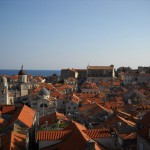
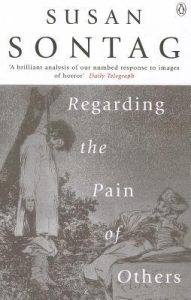 I tried to forget about the graves as we flew to Dubrovnik and entered the beautiful, walled old Town. For a couple of days I was a right good tourist exploring the sights and spending money. But I kept looking for signs of the war. The guidebook said the only evidence we would see of the bombing of Dubrovnik was the new red tile roofs. It wasn’t until walked the walls that I saw that most of the roofs were the bright red of new tile. Almost no building was left untouched. I wanted to think that there were other reasons for some of the new roofs, but there were so many of them…I was curious and I wanted to know more, but I didn’t know who to ask and I didn’t want to be rude. I wanted to see the place for more than its war experiences, but I couldn’t stop thinking about it.
I tried to forget about the graves as we flew to Dubrovnik and entered the beautiful, walled old Town. For a couple of days I was a right good tourist exploring the sights and spending money. But I kept looking for signs of the war. The guidebook said the only evidence we would see of the bombing of Dubrovnik was the new red tile roofs. It wasn’t until walked the walls that I saw that most of the roofs were the bright red of new tile. Almost no building was left untouched. I wanted to think that there were other reasons for some of the new roofs, but there were so many of them…I was curious and I wanted to know more, but I didn’t know who to ask and I didn’t want to be rude. I wanted to see the place for more than its war experiences, but I couldn’t stop thinking about it.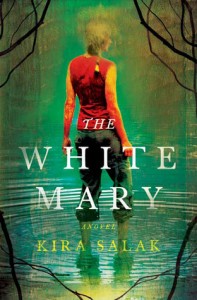 I read The White Mary by Kira Salak on a flight from Seattle to Paris at the start of my first trip abroad in four years. The story of a journalist on a quest for her idol who the world thinks is dead but she thinks might be alive in the deep jungles of Papua New Guinea seemed like an auspicious start to my own (much tamer) adventure: a family trip to Croatia.
I read The White Mary by Kira Salak on a flight from Seattle to Paris at the start of my first trip abroad in four years. The story of a journalist on a quest for her idol who the world thinks is dead but she thinks might be alive in the deep jungles of Papua New Guinea seemed like an auspicious start to my own (much tamer) adventure: a family trip to Croatia.